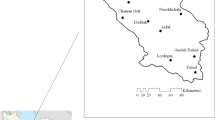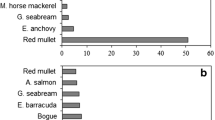Abstract
Although fish consumption has positive health effects, metals accumulated in fish can cause human health risks. In this study, the levels of ten metals in rainbow trout (Oncorhynchus mykiss) farmed in the Keban Dam Reservoir, which has the biggest rainbow trout production capacity in Turkey, were determined and compared with the maximum permissible levels (MPLs). Also, human health risks associated with rainbow trout consumption were assessed. The metal concentrations in rainbow trout were found below the MPLs. The estimated daily intake of each metal was much lower than the respective tolerable daily intake. The target hazard quotient (THQ) for individual metal and total THQ for combined metals did not exceed 1, indicating no health risk for consumers. The cancer risk (CR) value for inorganic arsenic was within the acceptable lifetime risk range of 10−6 and 10−4. For carcinogenic and non-carcinogenic effects, the maximum allowable fish consumption rates were high enough to ensure the human health. According to these results, the consumption of rainbow trout farmed in the Keban Dam Reservoir does not pose a risk on human health.




Similar content being viewed by others
References
Fallah AA, Saei-Dehkordi SS, Nematollahi A, Jafari T (2011) Comparative study of heavy metal and trace element accumulation in edible tissues of farmed and wild rainbow trout (Oncorhynchus mykiss) using ICP-OES technique. Microchem J 98:275–279
Copat C, Arena G, Fiore M, Ledda C, Fallico R, Sciacca S, Ferrante M (2013) Heavy metals concentrations in fish and shellfish from eastern Mediterranean Sea: consumption advisories. Food Chem Toxicol 53:33–37
Rahman MS, Molla AH, Saha N, Rahman A (2012) Study on heavy metals levels and its risk assessment in some edible fishes from Bangshi River, Savar, Dhaka, Bangladesh. Food Chem 134:1847–1854
Kalantzi I, Pergantis SA, Black KD, Shimmield TM, Papageorgiou N, Tsapakis M, Karakassis I (2016) Metals in tissues of seabass and seabream reared in sites with oxic and anoxic substrata and risk assessment for consumers. Food Chem 194:659–670
Ahmed MK, Baki MA, Kundu GK, Islam MS, Islam MM, Hossain MM (2016) Human health risks from heavy metals in fish of Buriganga river, Bangladesh. SpringerPlus 5:1697
Qin D, Jiang H, Bai S, Tang S, Mou Z (2015) Determination of 28 trace elements in three farmed cyprinid fish species from Northeast China. Food Control 50:1–8
USEPA (US Environmental Protection Agency) (2000) Guidance for assessing chemical contaminant data for use in fish advisories, Volume II risk assessment and fish consumption limits. EPA 823-B-00-008. United States Environmental Protection Agency, Washington, DC
USEPA (U S Environmental Protection Agency) (1989) Risk assessment guidance for superfund, volume I. Human health evaluation manual part a, interim final. EPA/540/1–89/002. United States Environmental Protection Agency, Washington, DC
Yu Y, Wang X, Yang D, Lei B, Zhang X, Zhang X (2014) Evaluation of human health risks posed by carcinogenic and non-carcinogenic multiple contaminants associated with consumption of fish from Taihu Lake, China. Food Chem Toxicol 69:86–93
Saha N, Mollah MZI, Alam MF, Rahman MS (2016) Seasonal investigation of heavy metals in marine fishes captured from the Bay of Bengal and the implications for human health risk assessment. Food Control 70:110–118
Griboff J, Wunderlin DA, Monferran MV (2017) Metals, As and Se determination by inductively coupled plasma-mass spectrometry (ICP-MS) in edible fish collected from three eutrophic reservoirs. Their consumption represents a risk for human health? Microchem J 130:236–244
FAO (Food and Agriculture Organization) (2005) National Aquaculture Sector Overwiew: Turkey http://www.fao.org/fishery/countrysector/naso_turkey/en/
GDFA (General Directorate of Fisheries and Aquaculture) (2016) Fisheries statistics. Republic of Turkey Ministry of Food Agriculture and Livestock. http://www.tarim.gov.tr/sgb/Belgeler/SagMenuVeriler/BSGM.pdf
Güner B (2015) Aquafishing in Keban Dam Lake. Fırat Univ J Soc Sci 25:1–8
Makedonski L, Peycheva K, Stancheva M (2017) Determination of some heavy metal of selected black sea fish species. Food Control 72:313–318
Mendil D, Ünal ÖF, Tüzen M, Soylak M (2010) Determination of trace metals in different fish species and sediments from the River Yeşilırmak in Tokat, Turkey. Food Chem Toxicol 48:1383–1392
Tao Y, Yuan Z, Xiaona H, Wei M (2012) Distribution and bioaccumulation of heavy metals in aquatic organisms of different trophic levels and potential health risk assessment from Taihu Lake, China. Ecotoxicol Environ Saf 81:55–64
Kelly BC, Ikonomou MG, Higgs DA, Oakes J, Dubetz C (2008) Mercury and other trace elements in farmed and wild salmon from British Columbia, Canada. Environ Toxicol Chem 27:1361–1370
FSANZ (Food Standards Australia and New Zealand) (2013) Australia New Zealand Food Standards Code. Standard 141. Contaminants and natural toxicants http://www.legislation.gov.au/Details/F(2013)C00140/
FAO (Food and Agriculture Organization) (1983) Compilation of legal limits for hazardous substances in fish and fishery products. FAO Fishery Circular No 464. Food and Agriculture Organization of the United Nations, Rome
EC (Commission of the European Communities) (2006) Commission Regulation (EC) No 1881/2006 of 19 December 2006: setting maximum levels for certain contaminants in foodstuffs. Off J Eur Union Legis 364. http://eur-lex.europa.eu/legal-content/EN/TXT/PDF/?uri=CELEX:32006R1881from=EN/
WHO/FAO (World Health Organization/Food and Agriculture Organization) (2015) Codex alimentarius commission. General standard for contaminants and toxins in food and feed. CODEX STAN 193–1995
MHPRC (Ministry of Health of the People’s Republic of China) (2013) National food safety standard, maximum levels of contaminants in foods (GB2762–2012) http://www.seafish.org/media/publications/China_Max_levels_of_contaminants_in_food.pdf
JECFA (Joint FAO/WHO Expert Committee on Food Additives) (1982) Evaluation of certain food additives and contaminants. Twenty-sixth report of the Joint FAO/WHO Expert Committee on Food Additives. WHO technical report series, no 683. World Health Organization, Geneva
JECFA (Joint FAO/WHO Expert Committee on Food Additives) (1983) Evaluation of certain food additives and contaminants. Twenty-seventh report of the Joint FAO/WHO Expert Committee on Food Additives. WHO technical report series, no 696. World Health Organization, Geneva
JECFA (Joint FAO/WHO Expert Committee on Food Additives) (1989) Evaluation of certain food additives and contaminants. Thirty-third report of the Joint FAO/WHO Expert Committee on Food Additives. WHO technical report series, no 776. World Health Organization, Geneva
JECFA (Joint FAO/WHO Expert Committee on Food Additives) (2011) Evaluation of certain food additives and contaminants. Seventy-third report of the Joint FAO/WHO Expert Committee on Food Additives. WHO technical report series, no 960. World Health Organization, Geneva
EFSA (European Food Safety Authority) (2010) Scientific opinion on lead in food. EFSA J 8(4):1570
EFSA (European Food Safety Authority) (2014) Scientific opinion on dietary reference values for chromium. EFSA J 12(10):3845
WHO (World Health Organization) (2011) Guidelines for drinking water quality, 4th edn. World Health Organization, Geneva
USEPA (US Environmental Protection Agency) (2016) Integrated risk information system https://www.epa.gov/iris/
Finley BL, Monnot AD, Paustenbach DJ, Gaffney SH (2012) Derivation of a chronic oral reference dose for cobalt. Regul Toxicol Pharmacol 64:491–503
Raknuzzaman M, Ahmed MK, Islam MS, Habibullah-Al-Mamun M, Tokumura M, Sekine M, Masunaga S (2016) Trace metal contamination in commercial fish and crustaceans collected from coastal area of Bangladesh and health risk assessment. Environ Sci Pollut Res 23:17298–17310
Svobodova Z, Celechovska O, Machova J, Randak T (2002) Content of arsenic in market–ready rainbow trout (Oncorhynchus mykiss). Acta Vet Brno 71:361–367
Jiang H, Qin D, Mou Z, Zhao J, Tang S, Wu S, Gao L (2016) Trace elements in farmed fish (Cyprinus carpio, Ctenopharyngodon idella and Oncorhynchus mykiss) from Beijing: implication from feed. Food Addit Contam B 9:132–141
Santerre CR, Bush PB, Xu DH, Lewis GW, Davis JT, Grodner RM, Ingram R, Wei CI, Hinshaw JM (2001) Metal residues in farm-raised channel catfish, rainbow trout, and red swamp crayfish from the Southern US. J Food Sci 66:270–273
Shaheen N, Ahmed MK, Islam MS, Habibullah-Al-Mamun M, Tukun AB, Islam S, Rahim ATMA (2016) Health risk assessment of trace elements via dietary intake of ‘non-piscine protein source’ foodstuffs (meat, milk and egg) in Bangladesh. Environ Sci Pollut Res 23:7794–7806
Lourenço HM, Afonso C, Anacleto P, Martins MF, Nunes ML, Lino AR (2012) Elemental composition of four farmed fish produced in Portugal. Int J Food Sci Nutr 63(7):853–859
ATSDR (Agency for Toxic Substances and Disease Registry) (2004) Toxicological profile for Copper. US Department of Health and Human Services, Public Health Service, Atlanta
Gokoglu N, Yerlikaya P, Cengiz E (2004) Effects of cooking methods on the proximate composition and mineral contents of rainbow trout (Oncorhynchus mykiss). Food Chem 84:19–22
EFSA (European Food Safety Authority) (2004) Opinion of the scientific panel on dietetic products, nutrition and allergies [NDA] related to the tolerable upper intake level of iron. EFSA J 125:1–34
ATSDR (Agency for Toxic Substances and Disease Registry) (2012) Toxicological profile for Manganese. US Department of Health and Human Services, Public Health Service, Atlanta
Guo H, Chen L, Cui H, Peng X, Fang J, Zuo Z, Deng J, Wang X, Wu B (2016) Research advances on pathways of nickel-induced apoptosis. Int J Mol Sci 17:10
Hedera P, Peltier A, Fink JK, Wilcock S, London Z, Brewer GJ (2009) Myelopolyneuropathy and pancytopenia due to copper deficiency and high zinc levels of unknown origin II. The denture cream is a primary source of excessive zinc. NeuroToxicology 30:996–999
Costanza J, Lynch DG, Boethling RS, Arnot JA (2012) Use of the bioaccumulation factor to screen chemicals for bioaccumulation potential. Environ Toxicol Chem 31:2261–2268
Hogstrand C (2012) Zinc. In: Wood CM, Farrell AP, Brauner CJ (eds) Homeostasis and toxicology of essential metals. Academic press, pp 135–200
Acknowledgements
This work was supported by Munzur University Scientific Projects Coordination Department (Project Number: YLTUB015-07). Special thanks are given to the anonymous reviewers and editor Prof. John B. Vincent for their constructive comments for improving the manuscript.
Author information
Authors and Affiliations
Corresponding author
Rights and permissions
About this article
Cite this article
Varol, M., Kaya, G.K., Alp, S.A. et al. Trace Metal Levels in Rainbow Trout (Oncorhynchus mykiss) Cultured in Net Cages in a Reservoir and Evaluation of Human Health Risks from Consumption. Biol Trace Elem Res 184, 268–278 (2018). https://doi.org/10.1007/s12011-017-1156-2
Received:
Accepted:
Published:
Issue Date:
DOI: https://doi.org/10.1007/s12011-017-1156-2




